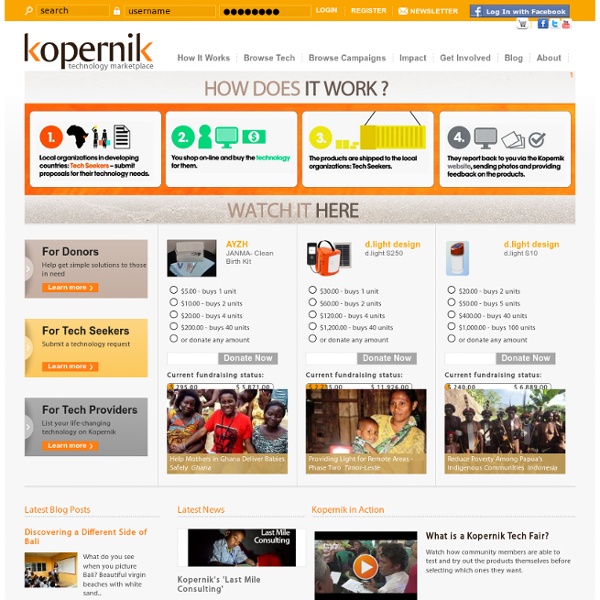



Hi Noroshi How Crowdfunding Could Help Cure Rare Diseases LONG BEACH, Calif. — By definition, rare diseases are hard to diagnose, receive little research funding, and are challenging to treat. One organization is trying to change all that through a crowdfunding model specifically aimed at helping those with the nearly 7,000 rare diseases in the U.S. Dubbed the Rare Genomics Institute, the non-profit organization could be considered a Kickstarter for genomics. The project first connects a patient with a research institution that’s willing to take their case, and then develops a budget that can be funded by friends, family and online supporters. The organization’s founder Jimmy Lin shared the stories of some of the patients using the service this week at TED. Anyone can view any patient's story on the Rare Genomics Insitute’s site, which describes the symptoms of the rare diseases that the patient is facing, then offers visitors a way to make a donation towards research. Image Credit: Ryan Lash
Startups Challenge Energy poverty Energy poverty is a lack of access to modern energy services. These services are defined as household access to electricity and clean cooking facilities (e.g. fuels and stoves that do not cause air pollution in houses). Modern energy services are crucial to human well-being and to a country’s economic development; and yet globally over 1.3 billion people are without access to electricity and 2.6 billion people are without clean cooking facilities. The lack of access to modern energy services is a serious hindrance to economic and social development, and must be overcome if the UN Millennium Development Goals are to be achieved. For a decade, the World Energy Outlook (WEO) has highlighted the crucial role that energy access plays in a country’s development. Modern Energy for All 2013 Electricity Access Database
Beth Kanter's Blog Ratio Juris: Toward a Philosophically Sound & Bioethically Sensitive Definition of Public Health Law Please Note: I’m hoping to receive (hence inviting) comments on this (either here or through e-mail) before penning the next draft, which will include material on the relation between the State and the pursuit of the Good (as one critical assumption or premise) and a small section treating the role of a certain take on the Constitution and the proposal outlined here. The final draft will be posted at SSRN. Public health law can be defined as the legal powers and duties of the state and/or other legal normative order(s) directed toward establishing, encouraging, and/or maintaining the necessary conditions for the health of individuals with respect to four types of functions and capacities: biological (e.g., well-functioning organs); physical (e.g., ambulatory); social (e.g., capacities to communicate); and mental (e.g., reasoning and emotional capabilities). Public health law is plausibly viewed as giving life to many of the necessary conditions for individual and social well-being.
Prove My Concept | Practical tools for entrepreneurial students interested in starting their own businesses Universal Energy Access | Sustainable Energy for All Sustainable energy powers opportunity. Yet 1.3 billion people—one in five globally—lack electricity to light their homes or conduct business. Sustainable development is not possible without sustainable energy Nearly 40% of the world’s population rely on wood, coal, charcoal, or animal waste to cook their food breathing in toxic smoke that causes lung disease and kills nearly two million people a year, most of them women and children. Electricity enables children to study after dark. Replacing outdated cookstoves and open fires with modern energy services would save the lives of 800,000 children who die each year as a result of exposure to indoor smoke. Private-sector investment is key to building and serving those markets Energy can be used to support businesses and achieve greater prosperity. Without sustainable energy, we will not meet the Millennium Development Goals. Greater prosperity means more disposable income and new markets for consumer goods. Energy Access Fact Sheet
Nonprofit Tech 2.0 Blog :: A Social Media Guide for Nonprofits Reduction in child mortality in Niger: a Countdown to 2015 country case study This article can be found in the following collections: Global Health;Paediatrics(Paediatrics-other) Copyright © 2012 Elsevier Ltd All rights reserved. Background The Millennium Development Goal 4 (MDG 4) is to reduce by two-thirds the mortality rate of children younger than 5 years, between 1990 and 2015. Methods We developed new estimates of child and neonatal mortality for 1998—2009 using a 2010 household survey. Findings The mortality rate in children younger than 5 years declined significantly from 226 deaths per 1000 livebirths (95% CI 207—246) in 1998 to 128 deaths (117—140) in 2009, an annual rate of decline of 5·1%. Interpretation Government policies supporting universal access, provision of free health care for pregnant women and children, and decentralised nutrition programmes permitted Niger to decrease child mortality at a pace that exceeds that needed to meet the MDG 4. Funding This article is made available free of charge, as a service to our users.